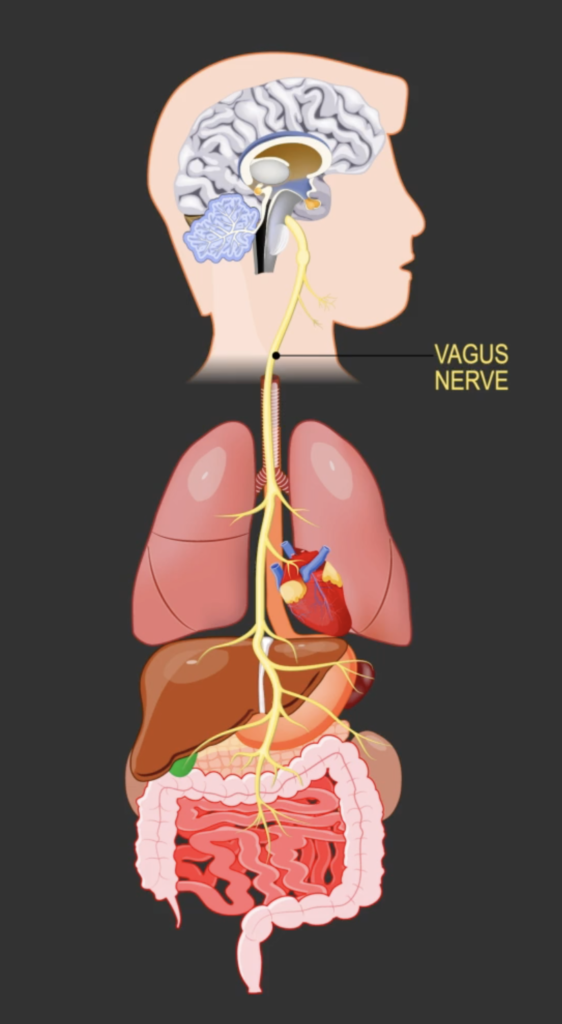What’s the quickest way to reset your nervous system?
. . . Breathe
The vagus nerve is the longest nerve in the body. As part of the parasympathetic nervous system (PNS), it’s responsible for our “rest + digest” functions and directly influences and is influenced by our internal organs.
The sympathetic nervous system (SNS), on the other hand, follows blood vessels and controls our “fight, flight or freeze” response. When activated, it puts us on high alert, blood rushing to our extremities and away from our core to prepare us to escape from the tiger.
Even if there aren’t any tigers in your neighborhood, the PNS doesn’t know this. It can’t tell the difference between being stuck in traffic and late for a meeting and an attacking tiger: the result is the same. We get stressed.
The vagus nerve (VN) descends from the brainstem at the back of the neck and travels down the body to touch and influence the heart, lungs and all the internal organs including the liver, stomach, kidneys and intestines. The VN also receives information from the heart, lungs + viscera and reports it back to the brain.
It wanders . . . hence its name. Vagus comes from the same Latin root as vagabond.
Upon inhalation, the diaphragm contracts (flattens) putting pressure on the viscera (guts) below it. “Breathing into your pelvic bones” as in the exercise below, increases this pressure downward all the way to the pelvic floor. Pressure descending into the depths of your core canister stimulates the internal organs on the way.
This pressure, generated by deep breathing in the lungs and the diaphragmatic contraction, stimulates the VN. Stress hormones are regulated. Signals are sent to the brain that there’s no tiger chasing us and we’re not late for a meeting.
The rest + digest function is set in motion. We relax.
Universal Set Up
- Sit back in child’s pose position with your buttocks on your heels
- Elevate the pelvis with pillows if necessary
- Elevate the pelvis with pillows if necessary
- Place either 2 yoga blocks under the forehead + 1 under each elbow or 1 yoga block under the forehead
- Hand over hand, forehead on hands
- Hand over hand, forehead on hands
- Tuck the tail under posteriorly tilting the pelvis
Action
- INHALE ➼ On a count of 5, breathe into the sacrum, coccyx, sit bones, hip joints, pubis in the front and equally importantly, breathe into the low back, lumbar areas
- To breathe into the lumbar spine, imagine breathing laterally into the side ribs
- To breathe into the lumbar spine, imagine breathing laterally into the side ribs
- Belly breathing will be automatically restricted from the pressure of the thighs against the belly ➼ that’s on purpose!
- EXHALE ➼ Breathe out for a count of 10 (or double your in-breath count) either through the nose or making the “Ha” sound while thinking of fogging a mirror
- If the back + side thorax are restricted either through tight paraspinals / thoracolumbar fascia or simply because you’re not used to expanding these areas, you may find it hard to get a full, deep breath in. If the inhale is shortened because of this, the exhale may leave you “air hungry.”
- That’s ok. Just practice and soon you’ll be able to expand the posterior thorax through the breath instead of sending the breath primarily to the belly.
- That’s ok. Just practice and soon you’ll be able to expand the posterior thorax through the breath instead of sending the breath primarily to the belly.
- Shoulder shrugging with the inhale is another sign of an inability to breathe fully into the thorax ➼ accessory respiratory muscles such as the scalenes and SCMs take over to get the breath in and the shoulders shrug as a consequence.
- If by chance a bit of urine leaks out on the full inhale, take it as a good+bad sign: good because it shows you’ve actually “breathed into the pelvic bones.” That’s really good! Bad because it signals weak pelvic floor muscles that may need some attention. Much more to come in that regard soon.
Your body is your quickest go-to to calm your mind. You just have to remind yourself to breathe! Use this exercise to explore how deep breathing resets every cell in your being.








